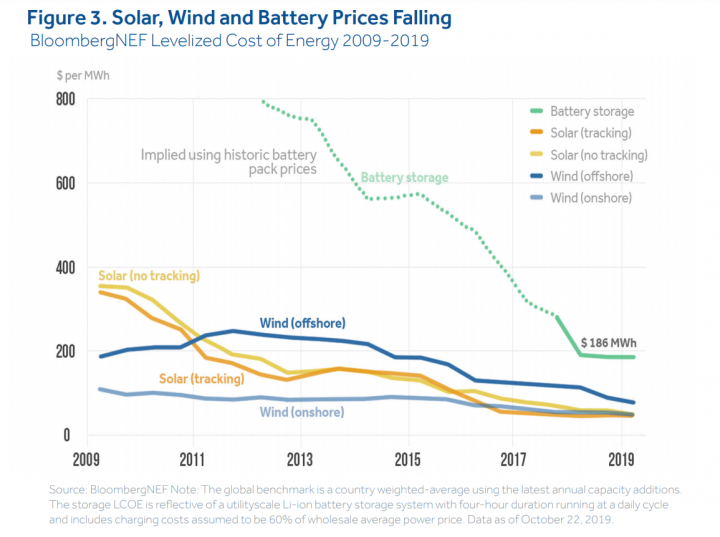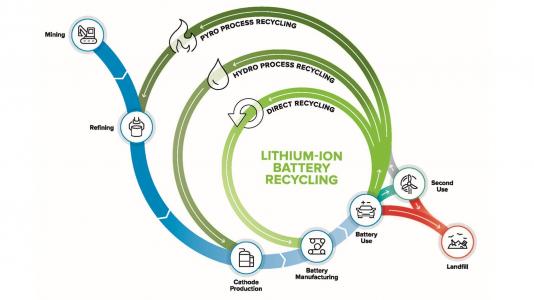Building Energy Storage
Introduction
As the electric grid evolves from a one-way fossil fuel-based structure to a more complex multi-directional system encompassing numerous distributed energy generation sources – including renewable and other carbon pollution free energy sources – the role of energy storage becomes increasingly important.
While energy can be stored, often in huge amounts, at the grid level, this page is about energy storage at the building level, and the benefits, challenges, opportunities and cautions for federal building professionals to take into account as they consider adding energy storage to their facilities.
(This content was built upon the GSA Green Building Advisory Committee’s Advice Letter: Recommendations for the Adoption of Energy Storage in Federal Buildings![]() .)
.)
Why Consider Building Energy Storage?
The capability to store energy allows building operators increased demand flexibility, an essential component of grid-integrated efficient buildings. That is, when you can store energy, you can control the level and timing of when you use energy or return it to the grid. This allows for:
- participation in demand response programs run by utilities or transmission organizations such as RTOs or ISOs;
- more refined building energy management, including taking advantage of time of use rates or limiting demand charges;
- better utilization of on-site energy generation resources, such as solar photovoltaics (PVs);
- a backup power source that can be accessed during power outages, potentially enhancing resilience.
Types of Energy Storage
There are numerous theoretical ways to store energy, which organizations such as the U.S. Department of Energy are continually researching. The two primary types of building energy storage presently available in the marketplace are battery storage and thermal storage.
Building battery storage is not theoretically different from the familiar use of batteries in home appliances and cars: they store chemical energy to convert it on demand into electrical energy. Lithium-ion batteries are the dominant technology used in buildings at this time.
Thermal storage, by contrast, involves the direct storage of heat or cooling energy for later use. The most common storage medium is water, as when energy during the least expensive hours is used to freeze water into ice, which is then melted when needed during the day for air conditioning. Water heaters can also be used to store hot water for when it is most needed.
Economic and Financial Opportunities
While building battery storage systems have long been expensive for many applications, prices have been falling dramatically, to the point that investment in such systems may merit consideration in some areas. Factors to be considered include the local cost of energy, available utility rates and programs, and other state programs to encourage the use of storage.

The DSIRE website![]() tracks state and utility financial incentives, such as the California Energy Commission’s Self-Generation Incentive Program (SGIP)
tracks state and utility financial incentives, such as the California Energy Commission’s Self-Generation Incentive Program (SGIP)![]() , a rebate program, and the Maryland Energy Storage Income Tax Credit
, a rebate program, and the Maryland Energy Storage Income Tax Credit![]() .
.
Energy storage projects have been included in financing packages including Energy Savings Performance Contracts (ESPCs), Utility Energy Service Contracts (UESCs), and Power Purchase Agreements (PPAs).
Additional Considerations
While energy storage is increasingly being used with success across the country, there are a number of factors to take into account before making the decision to install storage resources at one’s facility.
First, storage requires sufficient and adequate space on the inside or outside of the building. Storage units can be heavy, limiting where they may be placed.
Facility managers and staff will need proper training to operate storage facilities; ice storage, for example, can be challenging to manage. Building management systems (BMSs) may be programmed to optimize storage use. Fire safety is another important consideration for the use of batteries in buildings. Battery systems need to be designed to ensure that they do not generate excess heat to the point of what is called “thermal runaway.” Multiple industry standards have been developed to require safe design and operation, including product standards UL 9540, UL 1642, UL 1973, UL 1741, and UL 62109, testing standard UL9540A, International Fire Code (IFC) Section 1206 and National Fire Protection Association (NFPA) Standard 855.
In terms of the impacts of batteries across their whole life cycle, there are considerations at both the sourcing and end-of-life stages. The mining of lithium for batteries has raised environmental and human rights issues in several countries. At the end-of-life phase, programs for the recycling of building battery systems still need to be developed in many locations.

Case studies
GSA’s first battery system has been successfully operating at the Edward J. Schwartz Federal Building & U.S. Courthouse in San Diego, CA since January 2018. This 750 kilowatt (kW) lithium-ion system is capable of several on-grid applications including tariff optimization, peak load shaving, energy shifting, and automated demand response. It was implemented through an Energy Savings Performance Contract (ESPC).
The U.S. Department of Defense has experimented with energy storage systems at a number of its military bases. The Army's Fort Carson base in Colorado Springs, Colorado implemented a battery storage system in January 2019. This system uses artificial intelligence to forecast electrical demand peaks and regulates the timing, intensity, and duration of charge/discharge cycles. This system was also installed through the use of an ESPC. (See National Renewable Energy Lab (NREL) study![]() and a 2019 presentation
and a 2019 presentation![]() on the system.)
on the system.)
Resources
Following are several resources to facilitate facility manager understanding and evaluation of building energy storage systems:
- GSA’s Green Building Advisory Committee developed the following set of findings and recommendations regarding the use of energy storage at federal facilities:
- Energy storage is an important component of grid-integrated efficient building (GEB) design and operation.
- The U.S. Department of Energy (DOE) and its national labs are conducting significant research on energy storage, as well as gathering best practices and providing technical assistance. See:
- DOE Building Technologies Office (BTO) Thermal Energy Storage research

- DOE Office of Electricity (OE) Energy Storage program

- Joint Center for Energy Storage Research (JCESR)
 , a DOE-funded Energy Innovation Hub including a consortium of national laboratories led by Argonne National Laboratory
, a DOE-funded Energy Innovation Hub including a consortium of national laboratories led by Argonne National Laboratory - DOE’s Energy Information Administration (EIA)
 provides analyses of energy storage market trends
provides analyses of energy storage market trends
- DOE Building Technologies Office (BTO) Thermal Energy Storage research
- Non-governmental resources
- The Energy Storage Association (ESA)
 has a wide variety of information about the industry and its technologies.
has a wide variety of information about the industry and its technologies. - The Database of State Incentives for Renewable Energy (DSIRE)
 website tracks state and utility financial incentives for energy storage.
website tracks state and utility financial incentives for energy storage.
- The Energy Storage Association (ESA)


